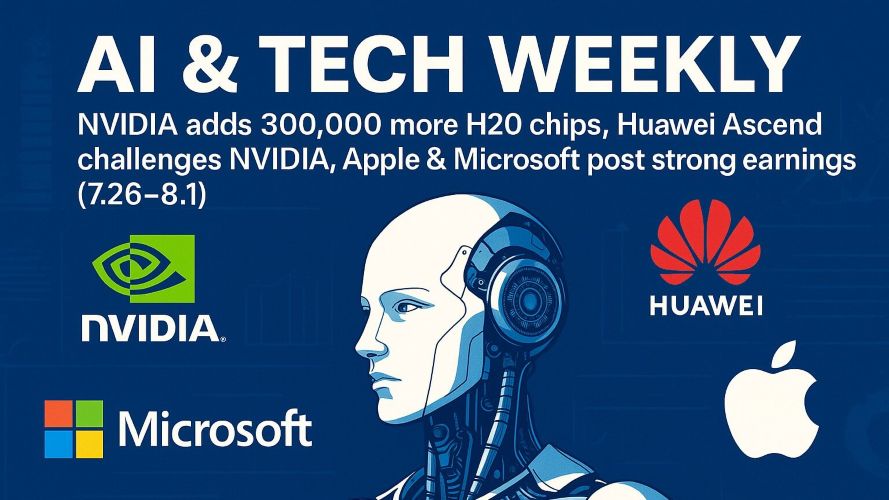AI Navigation
- articleAI Trends
- lightbulb_2AI Tips
- assistant_navigationAI Navigation
- heatHot Articles
- emergency_heat_2Hot Tips
- format_list_numberedPrompt Formatter
- psychologyTest Center(RPI)
AI & Tech Weekly: NVIDIA Adds 300,000 More H20 Chips, Huawei Ascend Challenges NVIDIA, Apple & Microsoft Post Strong Earnings (7.26–8.1)
Over the past week, competition in the global AI and tech sectors has intensified. NVIDIA placed an emergency order for 300,000 additional H20 chips from TSMC to meet surging demand in China. Huawei unveiled its Ascend 384 Super Node for the first time at WAIC, a milestone for China’s domestic computing ecosystem. Meanwhile, Apple, Microsoft, and Meta all reported strong earnings, underscoring that AI has become the driving force behind Big Tech’s growth.
This weekly briefing covers five key events shaping the current and future AI landscape.

NVIDIA Orders 300,000 More H20 Chips: A Clear Signal to Target China’s Market
Amid surging demand for AI computing power in China, NVIDIA placed an emergency order for 300,000 additional H20 chips with TSMC, bringing its total inventory to around 600,000–700,000 units. This marks NVIDIA’s first major move in the Chinese market since the U.S. eased export restrictions in April.
Commentary: This order sends a multi-layered message.
In the short term, NVIDIA still needs individual licenses from the U.S. Department of Commerce for each shipment, meaning policy uncertainty remains high. In the mid-term, the order reflects China’s urgent demand for high-end GPUs as the country rapidly builds AI training infrastructure and data centers. Over the long term, while NVIDIA remains dominant in the GPU market, the rise of domestic challengers like Huawei Ascend, Cambricon, and Biren Technologies could begin to erode that advantage in the coming years.
Huawei Ascend 384 Super Node Debuts: A Milestone for China’s Computing Ecosystem
At the 2025 World Artificial Intelligence Conference (WAIC), Huawei showcased its Ascend 384 Super Node for the first time—a flagship AI computing platform widely viewed as Huawei’s boldest move yet to rival NVIDIA’s top-tier products. The system features a modular design and a high energy-efficiency ratio, drastically reducing the cost of AI workloads such as scientific research, autonomous driving, cloud computing, and large-model training.
Commentary: The launch of Ascend 384 is not just a product debut; it’s a strategic statement.
In the short term, it can partially substitute NVIDIA GPUs and ease the supply crunch in China. In the mid-term, with companies like Baidu, Meituan, and ByteDance already deploying the platform, China’s domestic computing ecosystem will mature rapidly. Looking ahead, Ascend 384 could reshape the global AI compute landscape, setting the stage for direct, high-stakes competition between Huawei and NVIDIA.
Apple’s Q3 Earnings Beat Expectations: iPhone Rebounds, Services Surge
Apple’s fiscal Q3 2025 results impressed markets:
-
Total revenue: $94.036 billion, up 10% year over year
-
Net profit: $23.434 billion, up 9% year over year
-
iPhone sales: $44.58 billion, up 13% year over year
-
Services revenue: $26.34 billion, up 13%, hitting a record high
Commentary: Apple’s earnings confirm the resilience of its ecosystem moat.
iPhone sales bounced back sharply, reversing declines in Greater China, while services (App Store, iCloud, Apple Music) became the star growth driver, highlighting the strength of Apple’s “hardware + services” strategy. However, weaknesses remain—wearables declined, and Apple’s relatively cautious AI rollout has raised questions about whether it can keep pace with Microsoft and Google in the generative AI race. Apple’s ability to deliver breakthrough AI products in the next 1–2 years will be crucial to sustaining investor confidence.
Microsoft Brings Copilot to Edge Browser: AI Productization Speeds Up
Microsoft introduced a new Copilot mode for its Edge browser, shifting it from a simple information retrieval tool into an “intelligent problem-solving assistant,” with features like tab filtering and intent recognition.
At the same time, Microsoft’s financials once again beat expectations:
-
Revenue: $76.44 billion, up 18% year over year — the fastest growth in three years
-
Net profit: $27.23 billion; EPS: $3.65, beating forecasts of $3.37
Commentary: Microsoft’s AI strategy is spreading across its entire product lineup—Bing Search, Office, Azure, and now Edge.
Copilot integration positions the browser as the new battleground for AI search and user interaction, intensifying competition with Google Chrome (Gemini). Azure’s continued rapid growth cements Microsoft’s transformation from a “software company” into a “full-stack AI platform leader.”
Meta Delivers Strong Earnings: Ads Solid, AI Still Catching Up
Meta’s Q2 2025 earnings impressed investors:
-
Revenue: $47.52 billion, beating expectations
-
Advertising revenue: up 21.5% year over year, driven by Reels and Advantage+
-
Stock surged over 11% in after-hours trading
Commentary: Meta’s ad business continues to prove its robust monetization engine, but its AI strategy lags behind Microsoft and Google.
Generative AI product rollouts have been slow, with no blockbuster consumer AI launches yet. Still, Meta’s aggressive acquisition strategy and deep AI talent pool suggest it hasn’t given up. If Meta can tightly integrate AI into Facebook, Instagram, and WhatsApp, it may yet carve out a stronger position in the AI market.
Conclusion
This week revealed three clear trends in AI and tech: accelerating compute hardware competition, intensifying U.S.-China tech tensions, and the rapid productization of AI. NVIDIA vs. Huawei in GPUs, Microsoft vs. Google in browsers, and Apple vs. Meta in consumer AI—all of these battles are shaping the next phase of the global tech landscape.
In the coming weeks, investors and industry watchers will focus on U.S. export policy, Huawei’s Ascend ecosystem rollout, and the pace of AI innovation from Apple and Microsoft. The AI race is only just beginning—the next “tech inflection point” may already be on the horizon.
More in-depth AI analysis, visit https://iaiseek.com